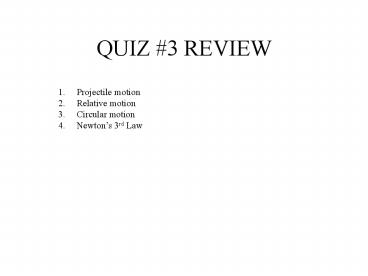QUIZ - PowerPoint PPT Presentation
1 / 31
Title:
QUIZ
Description:
(2) It is critically important to understand which vector is the ... files directly from Mega City to Smallville which lies 100 km directly north of Mega City. ... – PowerPoint PPT presentation
Number of Views:54
Avg rating:3.0/5.0
Title: QUIZ
1
QUIZ 3 REVIEW
- Projectile motion
- Relative motion
- Circular motion
- Newtons 3rd Law
2
Projectile motion
3
The speed of an object in projectile motion is a
minimum at the apex.
4
R
5
How to solve relative velocity problems.
Nearly all relative velocity problems involve
three vectors. Do the following (1) Draw the
picture (2) It is critically important to
understand which vector is the sum of the
other two. (3) solve for unknown quantity by
either vector arithmetic or trigonometry
6
Example 1
An airplane files north in air that is moving
towards the southeast (its called wind). The
sum is what an observer on the ground sees.
VP/A is what the velocity of the plane would
be if the air were still. look for air
speed or velocity in still air VA/G is what
the velocity of the air would be if the ground
were still, which it is.
VP/G is the sum of VP/A and VA/G It is what
the observer on the ground sees.
7
- The time taken to swim straight across is
(distance across) / (vy )
- Since you swim straight across, the sum of the
vectors must be in the y-direction.
8
A small airplane cruises at a speed of 240 km/hr
in still air. The pilot files directly from Mega
City to Smallville which lies 100 km directly
north of Mega City. The wind the day of the
flight is 80 km/hr towards the southeast. What is
the time of the flight?
9
How can we describe Uniform Circular Motion?
- In general, one coordinate system is as good as
any other - Cartesian
- (x,y) position
- (vx ,vy) velocity
- Polar
- (R,? ) position
- (vR ,? ) velocity
- In uniform circular motion
- R is constant (hence vR 0).
- ? (angular velocity) is constant.
- Polar coordinates are a natural way to describe
Uniform Circular Motion!
10
Summary
- Relationship between Cartesian and Polar
coordinates
- Angular motion
11
(No Transcript)
12
- A carnival Ferris wheel has a 15-m radius
and completes five turns about its horizontal
axis every minute. What is the magnitude of the
force exerted on a 70-kg passenger by her seat - At the top of the wheel?
- At the bottom of the wheel?
- (c) Half way between the bottom and the top?
What is the speed of the passenger and the
centripetal acceleration?
13
(No Transcript)
14
(No Transcript)
15
(No Transcript)
16
Ferris wheel Dynamics
17
Full Disclosure
mg
N
N
N
N
a
mg
mg
a
mg
18
Non-Uniform Circular Motion
Tangential Acceleration
Radial (centripetal) Acceleration
19
(No Transcript)
20
Dynamics of Non-Uniform Circular Motion
Just Newtons Second Law . . .
special case at constant
21
Non-Uniform Circular Motion constant at
angular acceleration
22
(No Transcript)
23
Newtons Third Law
- Forces are never lonely they always come in
pairs. - Each force in the (action/reaction) pair acts on
DIFFERENT objects - The two forces are equal in magnitude but
opposite in direction - (For every action, there is an equal and
opposite reaction.)
24
- Two blocks are stacked on the ground. How many
action-reaction pairs of forces are there? (Find
the number of pairs for each block and add these
numbers up.)
(1) one (2) two (3) three (4) four
a
b
25
Solution
(4) 4
26
A 2.0-kg box slides down the face of a 8.0-kg
wedge as shown. If all surfaces are
frictionless, what is the acceleration of the
wedge?
N
27
(No Transcript)
28
Coupled bodies with inclined plane
Let m 10kg, M30 kg and assume direction of
motion as shown.
T
Negative result means we picked wrong direction
of a
29
(No Transcript)
30
Inclined plane with friction
Let m 10kg, M30 kg and mk0.20 assume direction
of motion as shown.
- Will a be greater or less than frictionless case?
- (1) Greater (2) Less (3) the same
31
(No Transcript)

























![FIN 200 Week 8 Quiz [4 Sets] PowerPoint PPT Presentation](https://s3.amazonaws.com/images.powershow.com/7603710.th0.jpg?_=20150507085)
![FIN 200 Week 2 Quiz [3 Sets] PowerPoint PPT Presentation](https://s3.amazonaws.com/images.powershow.com/7603776.th0.jpg?_=20150507086)




